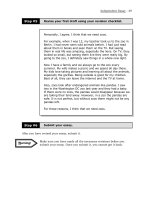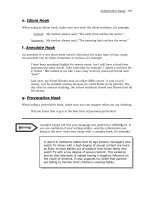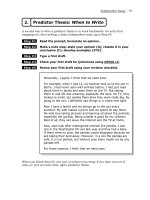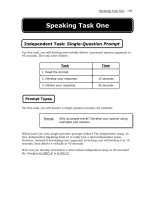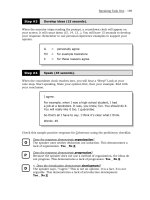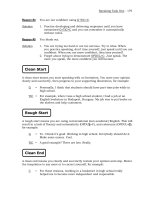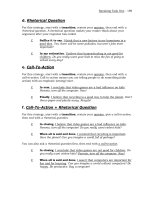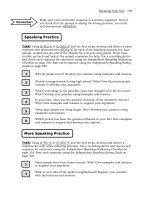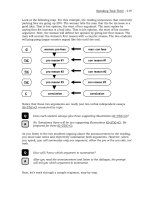Developing Data Management Policy and Guidance Documents for your NARSTO Program or Project ppt
Bạn đang xem bản rút gọn của tài liệu. Xem và tải ngay bản đầy đủ của tài liệu tại đây (1.84 MB, 59 trang )
Developing Data Management Policy and Guidance
Documents for your NARSTO Program or Project
A different approach to developing a data management plan in
the NARSTO context.
Following is a compilation of data management policy and guidance
documents for program and project use in developing data
management plans. Documents can be downloaded and implemented
individually or as a set, depending upon your data management
needs. Please be advised that this guidance and the referenced
resources will be periodically updated and that users should visit the
QSSC web site (link below) for the latest versions.
Getting started
–
• Select the data management guidance documents needed in your
Program or Project from the table of model documents that follows.
• Adopt, adapt, or refine these model documents as appropriate for
your needs with input from managers, investigators, modelers,
data coordinators, etc.
• Consult with the NARSTO QSSC for more information and
assistance.
• Distribute the approved documents to participants to inform them
of their data collection and reporting responsibilities.
• Ensure that adequate data coordination support is provided to all
participants to facilitate implementing the plans.
Prepared by the NARSTO Quality Systems Science Center (QSSC)
/>
Les A. Hook and Sigurd W. Christensen,
NARSTO Quality Systems Science Center
Environmental Sciences Division
Oak Ridge National Laboratory
Contact: Les Hook,
, 865-241-4846
ORNL research was sponsored by the U.S. Department of Energy and performed at Oak Ridge
National Laboratory (ORNL). ORNL is managed by UT-Battelle, LLC, for the U.S. Department of
Energy under contract DE-AC05-00OR22725.
QSSC Version 200504207
DM-0, Page 1
A different approach to developing a data management plan in the
NARSTO context, continued.
Overview of Data Policy and Management Plan Development
Rationale:
Providing this information to Project participants will inform
them of their data reporting responsibilities, promote consistency and
standardization in data and metadata collection and reporting processes,
and greatly facilitate data sharing, integration, synthesis, and analysis.
Guidance should be consistent with the needs of the Project.
Target Audience:
The audience for these guidance documents is the
investigators, experimentalists, modelers, and data coordinators
responsible for generating and submitting data to a Project database,
creating other data products, and archiving these data.
Guidance Documents:
Each document should be 1-2 pages in length (plus
attachments) and contain information that has been reviewed in light of
your Project data management needs. Guidance in the model DM
documents incorporates existing NARSTO data management protocols and
will often be suitable for use as is. Final guidance should be consistent
with the needs of the Project within the NARSTO context. Add additional
project-specific guidance as needed.
Document Development Process:
Ideally, the Project data coordinator will
take the lead on selecting the needed DM documents, coordinating the
project review, and modifying the guidance documents. The provided
model DM documents are in MSWord format and may be copied and
edited as needed. Please contact the QSSC if you have any problems with
the DM documents or have questions about the DM NARSTO guidance.
Authority:
Each guidance document should be approved by Project
management to ensure acceptance and implementation.
Distribution:
Ideally these will be web documents and would include links
to on-line Project documents (e.g., DM-4, Site ID table) and NARSTO
QSSC resources (e.g., variable name reference tables and DES format
template) at />. Hardcopies could be
provided as needed.
QSSC Version 200504207
DM-0, Page 2
Proposed Project Data Management Policy / Guidance Documents
Data Management Policy / Guidance Documents
Status /
Contact
Approved by /
Date
(yyyy/mm/dd)
> Organization
DM-1
Data Flow Overview
DM-2
Data Policy Considerations
DM-3
Project Name Information
DM-4
Identifying Measurement and Sampling Sites
> Data and Metadata Reporting
DM-5
Reporting Sampling and Measurement Dates and
Times
DM-6
Identifying Chemical and Physical Variables and
Descriptive Field Information
DM-7
Reporting Units for Chemical Variables, Particles,
and Physical and Descriptive Variables
DM-8
Assigning Project-Specific and NARSTO Data
Quality Flags
DM-9
Reporting and Flagging Values below Detection
Limits
DM-10
Reporting Missing Data
DM-11
Reporting Uncertainty Estimates
DM-12
Reporting Conventions for Mass Measurements,
Meteorological Data, and Temperature and
Pressure Conditions
> Data Documentation and Archiving
DM-13
Planning to Archive Data
DM-14
Creating Archive Documentation for Your Data Sets
DM-15
Creating a Searchable Index of Your Data Sets with
Links to the Data Files
DM-16
Capturing Sampling and Analysis Information –
Pre- and Post-Measurement
DM-17
Defining the Quality Level of Data
> Data Systems Management
DM-18
Day-to-Day Operation of Data Management
Systems
DM-19
Managing Electronic and Hardcopy Format Project
Records
DM-20
Data Management System and Software
Configuration Control Guidelines
QSSC Version 200504207
DM-0, Page 3
DM-1: Data Flow Overview BACK TO TABLE
SCOPE: Project (MCMA 2003 example)
PURPOSE:
To inform investigators and potential data users of the general
flow of data and information before, during, and after the
current field campaign. Data collected by investigators will be
provided to the MCMA database to meet project data analysis
needs. Certain data and metadata reporting standards are
necessary (e.g., DM-6, Variable naming) to facilitate efficient
data reporting, processing and analysis. Data will ultimately
be sent to the NARSTO Permanent Data Archive (PDA). Our
reporting standards are consistent with those for the NARSTO
PDA.
QSSC Version 20050407
DM-1, Page 1
Discussion:
The information is a general guide to carry out this process. Some larger projects have
onsite Data Managers who work with both the Principal Investigators and the NARSTO
QSSC. Other smaller projects do not have Data Managers, and the PIs interact directly
with the QSSC. While projects may have varying assigned roles and responsibilities for
data management, the QSSC is the source for information and assistance with data,
metadata, and archiving activities.
QSSC Version 20050407
DM-1, Page 2
DM-2: Data Policy Considerations BACK TO TABLE
SCOPE: Project
PURPOSE:
To involve all project managers and participants, as well as
potential data users in the formulation of a data policy. A clear statement of
the importance of the data collection effort and of the flow of the data and
information before, during, and after the current activities in the broadest
possible context is needed. It is a shared responsibility of all participants to
implement the data policy.
Vision:
Is it safe to assume that data and metadata will be shared among Project investigators,
and ultimately made available to the public in a timely manner through an archive
facility?
Who do you consider to be the audience for data beyond the Project team?
Will there be a Project data integration or synthesis effort in the future?
Do you see the value of the data as being short-term (3-5 years), mid-term (10 years),
or longer (20 years)?
Are these considerations the same for field measurement data, laboratory data, and
modeling products (input data, model code, and output results)?
Compliance with (as may be applicable):
• U.S. Government OMB CIRCULAR A 110, (REVISED 11/19/93, As Further Amended 9/30/99)
[ ]
• U.S. Government Agency implementations of “Guidelines for Ensuring and Maximizing the
Quality, Objectivity, Utility, and Integrity of Information Disseminated by Federal Agencies,” OMB,
2002. (67 FR 8452) [ ]
*** Example vision statement: The atmospheric sciences community is experiencing an unprecedented
increase in the types and amount of data being collected, modeled, and assessed. As projects evolve to
more focused, multi-investigator, interdisciplinary efforts in a period of limited resources, the timely
availability and sharing of data and documentation among participants becomes increasingly important.
The need for the use of this information beyond the project for climate assessments and air quality
management decisions has never been greater thus placing the additional responsibility on the project of
providing for the timely submission of quality controlled data to national data centers for wider public use.
***
Timeliness of Data Availability:
Considerations for timing of field measurement, laboratory, and modeling activities?
QSSC Version 20050407
DM-2, Page 1
Considerations for timing of laboratory results feeding modeling projects?
Rapid turn around of draft data within the Project? Justification?
Will data that are the subject of student theses or dissertations need special
consideration?
Will investigators be expected to maintain or archive raw data for specified periods of
time?
History tells us enforcement of data policies requires direct involvement by the Program
Manager (i.e., threat of no funding for non-compliance)
Quality Assurance:
Will each investigation develop a QA project plan? Will the Program have an
overarching QA plan? A final investigation QA summary report?
What level of QA is desirable for data to be shared within project? With the public?
Flagging data?
Encourage reporting of uncertainty measures with data values?
Detection limits?
Reporting of instrument calibrations and intercomparisons?
Will common data-processing protocols be used (e.g., gap-filling, block averaging,
standard software packages to convert voltages to concentrations)?
Data and Metadata Reporting:
Investigators have an obligation to make their data easy to use by others?
The Project will develop or adapt (e.g., from the QSSC) a formal description of preferred
conventions?
Consider extending use of uniform metadata reporting conventions beyond date and
time to include site names, parameter names, CAS RNs, units, methods, missing values
codes, quality flagging, etc.
Consider that searchable, standardized metadata improves synthesis and integration
efforts.
Data Archive:
Considerations for archiving: long-term system stability and longevity?
Consider types and amount of documentation for long-term data archiving – “twenty
year test”.
• Scientists are encouraged to document their data at a level sufficient to satisfy the well-known
“20-year test”. That is, someone 20 years from now, not familiar with the data or how they were
obtained, should be able to find data of interest and then fully understand and use the data solely
with the aid of the documentation archived with the data.( National Research Council, Committee
QSSC Version 20050407
DM-2, Page 2
on Geophysical Data, Solving the Global Change Puzzle, A U.S. Strategy for Managing Data and
Information, National Academy Press, Washington, D.C., 1991.)
Consider project maintenance and retention of raw/minimally processed instrument
data, software codes used for data processing, model code with input data and output
products, and hardcopy records.
Data Ownership/Control:
• The issue of data "ownership" is a difficult one.
o On the one hand a system must allow an instrument operator to reap the
rewards of their efforts.
o On the other hand the common good is served by sharing.
• The metadata should clearly state source of data, whether data are preliminary
and for use only among the project or suitable for widespread dissemination and
citation requirements.
• At some point there is a legal obligation for data collected with government funds
to be freely available.
• A decision is needed as to when the data sets are freely available to the outside
community.
• Conflict resolution?
Protection of Intellectual Property Rights:
• How will the Project help to ensure that intellectual property rights are protected
and co-authorship, acknowledgement, or credit is given to data originators and
principal investigators?
Consider the use of data in synthesis and integration studies that result in derived and
value-added products.
Example statement:
• When data are required for modeling or integrating studies, the originator of the data should be
consulted before data or derived products are incorporated or published in a review or integrated
study. The scientist collecting such data shall be credited appropriately by either co-authorship or
citation. (SAFARI 2000 DATA POLICY, February 5, 2001,
])
Example statement: AmeriFlux Data Fair-Use Policy
• The AmeriFlux data provided on this site are freely available and were furnished by individual
AmeriFlux scientists who encourage their use. Please kindly inform the appropriate AmeriFlux
scientist(s) of how you are using the data and of any publication plans. Please acknowledge the
data source as a citation or in the acknowledgments if the data are not yet published. If the
AmeriFlux Principal Investigators (PIs) feel that they should be acknowledged or offered
participation as authors, they will let you know and we assume that an agreement on such
matters will be reached before publishing and/or use of the data for publication. If your work
directly competes with the PI's analysis they may ask that they have the opportunity to submit a
manuscript before you submit one that uses unpublished data. In addition, when publishing,
please acknowledge the agency that supported the research. Lastly, we kindly request that those
QSSC Version 20050407
DM-2, Page 3
publishing papers using AmeriFlux data provide preprints to the PIs providing the data and to the
data archive at the Carbon Dioxide Information Analysis Center (CDIAC).
[ ]
QSSC Version 20050407
DM-2, Page 4
DM-3: Project Name Information BACK TO TABLE
SCOPE: Project (MCMA 2003 example)
PURPOSE: Provide standard names to identify the project, sampling sites,
data files, data sets, and FTP site area. Resources,
examples, and use in the NARSTO Data Exchange Standard
(DES) template are shown.
MCMA Names
Study or Network Short Acronym
(Starts with a letter. Use in site names, columns 1 - 4)
MCM3
Resource: DM-4 : Identifying fixed measurement sites
and mobile measurement platforms
*STUDY OR NETWORK ACRONYM
(Use in data file and data set names, chars 1-15)
*STUDY OR NETWORK NAME
MCMA_2003
Mexico City Metropolitan Area 2003
Field Campaign
Resource: Data Exchange Standard Template
*ORGANIZATION
ACRONYM
*ORGANIZATION NAME:
MIT_IPURGAP Massachusetts Institute of Technology Integrated Program
on Urban, Regional, and Global Air Pollution
Others?
Resource: Data Exchange Standard Template
Shared-Access FTP Site Information
Item
Project Info
UID
mcma (lower case)
Password
xxxxxxxx (case sensitive)
Internal/ directory name
mcma2003 (lower case)
Resource: [
QSSC Version 20050407
DM-3, Page 1
Data File and Data Set Naming
Limits
Data File:
[*STUDY OR NETWORK ACRONYM]_[unique data file descriptors]_V1.csv
Example: MCMA_2003_SMPS_WHERE_WHEN_V1.csv
Projects should define a standard syntax for the [unique data file descriptors] portion
of the data file name.
57 chars
max,
uppercase
(except .csv)
Data Set Title:
NARSTO [*STUDY_OR_NETWORK_ACRONYM] [Data Description]
Example: NARSTO MCMA_2003 Scanning Mobility Particle Size Data
80 chars
max, title
case
Data Set Name:
NARSTO_[STUDY_OR_NETWORK_ACRONYM]_[Abbreviated_Data_Description]
Example: NARSTO_MCMA_2003_SMPS_DATA
40 char max,
uppercase
Resource:
QSSC Version 20050407
DM-3, Page 2
Use of Project Name Information in DES Template (See large bolded
cells)
*DATA EXCHANGE STANDARD VERSION NARSTO 2005/04/29 (2.302)
*COMMENT
Further instructions on how to fill in this template are
provided at:
*COMMENT
/>o.html
*QUALITY CONTROL LEVEL
*DATE THIS FILE GENERATED/ARCHIVE VERSION NUMBER 2004/06/30
*ORGANIZATION ACRONYM
*ORGANIZATION NAME
*STUDY OR NETWORK ACRONYM
*STUDY OR NETWORK NAME
*FILE CONTENTS DESCRIPTION SHORT/LONG
*PRINCIPAL INVESTIGATOR NAME LAST/FIRST
*PRINCIPAL INVESTIGATOR AFFILIATION
*CO-INVESTIGATOR NAME LAST/FIRST
*CO-INVESTIGATOR AFFILIATION
*COUNTRY CODE
*STATE OR PROVINCE CODE
*SAMPLING INTERVAL AS REPORTED IN MAIN TABLE
*SAMPLING FREQUENCY OF DATA IN MAIN TABLE
*PRINCIPAL INVESTIGATOR CONTACT INFORMATION
*DATA USAGE ACKNOWLEDGEMENT
*NAME AND AFFILIATION OF PERSON WHO GENERATED
THIS FILE
*DATE OF LAST MODIFICATION TO DATA IN MAIN TABLE
*FILE CHANGE HISTORY VERSION NUMBER/DESCRIPTION
*NAME AND VERSION OF SOFTWARE USED TO CREATE
THIS FILE
*STANDARD CHARACTERS
!#$%&'()*,-
+=[]|./0123456789:;<>?@ABCDEFGHIJKLMNOPQRSTU
VWXYZ\^_`abcdefghijklmnopqrstuvwxyz{}~
*COMPANION FILE NAME/FORMAT AND VERSION
QSSC Version 20050407
DM-3, Page 3
DM-4: Identifying Measurement and Sampling Sites BACK TO TABLE
SCOPE: Project
PURPOSE: Provides a standard for identifying and characterizing fixed
measurement locations and mobile measurement platforms used by the
project as measurement and sampling sites. Specifications, resources,
examples, and use in the DES template are shown.
NARSTO Standard Site Identifier
The NARSTO Standard Site Identifier is constructed as follows for both fixed and mobile
sites.
Columns Contents
1 - 4 Study or network acronym (see DM-3), beginning with a letter
5 - 6 Country code (following the ISO3166 Standard)
7 - 8 State or Province
9 - 12 Site abbreviation (site mnemonic, 1 – 4 chars), beginning with a letter
Limits: The full 12 columns must be used, and no blanks are permitted. The last character of the site
identifier can be repeated to avoid blanks, or underscore (_) character(s) can be used instead of a blank.
Resource: Site Identifier Consensus Metadata Standard
[
Data Exchange Standard Template for country and state codes
Examples:
Fixed Site:
,SS99USTNBNA_,BNA_,BNA - NASHVILLE INTL AIRPORT,US (UNITED STATES)
,TN,36.1244767,-86.6781822, …
Mobile Site: (mobile platform is based at fixed site)
,SS99USTNG1PN,G1PN,Grumman G-1,US (UNITED STATES),TN,-999.99999,-999.99999, …
Fixed Site:
,ES2HUSTXEFD_,EFD_,EFD - ELLINGTON FIELD AIRPORT,US (UNITED STATES)
,TX,29.607333,-95.158750, …
Mobile Site: (same mobile platform is based at different fixed site)
,ES2HUSTXG1PN,G1PN,Grumman G-1,US (UNITED STATES),TX,-999.999999,-999.999999,
…
QSSC Version 20050407
DM-4, Page 1
Project Master List of Site Information
The project should maintain a master list of site identifiers, characteristics, and other
available information. Some items have picklists in the NARSTO Data Exchange
Standard template which also serve to explain the meaning of the item.
Key Information Needed to Adequately Characterize Measurement and Sampling Sites
*TABLE COLUMN NAME
FIELD
REQUIRED
OR
OPTIONAL
*TABLE
COLUMN
UNITS
*TABLE
COLUMN
FORMAT
TYPE
*TABLE
COLUMN
FORMAT
FOR
DISPLAY
*TABLE
COLUMN
MISSING
CODE
PICKLIST
AVAILABLE
IN THE DES
TEMPLATE
Site ID: standard REQUIRED
None Char 12 None
Site abbreviation: standard OPTIONAL
None Char 4 None
Description OPTIONAL
None Char 50 None
Country code REQUIRED
None Char 50 None
Yes
State or province code REQUIRED
None Char 20 None
Yes
Latitude: decimal degrees REQUIRED
Decimal
degrees
Decimal 10.5 -999.99999
Longitude: decimal degrees REQUIRED
Decimal
degrees
Decimal 10.5 -999.99999
Lat/lon reference datum REQUIRED
None Char 120 None
Yes
Sampling height above ground OPTIONAL
m (meter) Decimal 6.1 -99999.9
Ground elevation: above mean
sea level REQUIRED
m (meter) Decimal 6.1 -99.9
Pressure: site ground level OPTIONAL
hPa
(hectopasc
al)
Decimal 7.2 -99.99
Site land use REQUIRED
None Char 30 None
Yes
Site location setting REQUIRED
None Char 40 None
Yes
Measurement start date at site REQUIRED
yyyy/mm/dd Date 10 9999/12/31
Measurement end date at site REQUIRED
yyyy/mm/dd Date 10 9999/12/31
Co-incident measurements at
site
OPTIONAL
None Char 200 None
Site ID: study OPTIONAL
None Char 12 None
Lat/lon accuracy OPTIONAL
m (meter) Decimal 7.1 -999.9
Lat/lon method OPTIONAL
None Char 50 None
Yes
AIRS ID
REQUIRED
(conditional)
None Char 9 None
City/town OPTIONAL
None Char 25 None
County OPTIONAL
None Char 25 None
WMO region OPTIONAL
None Char 1 None
WDCA/GAW station type OPTIONAL
None Char 1 None
GAWID OPTIONAL
None Char 6 None
Comment OPTIONAL
None Char 120 None
Site nature (fixed or mobile site)
REQUIRED
(conditional)
None Char 6 None
Yes
Site location type OPTIONAL
None Char 20 None
Yes
Site: start date OPTIONAL
yyyy/mm/dd Date 10 9999/12/31
Site: end date OPTIONAL
yyyy/mm/dd Date 10 9999/12/31
Site: study start date OPTIONAL
yyyy/mm/dd Date 10 9999/12/31
Site: study end date OPTIONAL
yyyy/mm/dd Date 10 9999/12/31
Site population class OPTIONAL
None Char 30 None
Yes
Site type OPTIONAL
None Char 20 None
Yes
Site monitoring support OPTIONAL
None Char 30 None
Yes
QSSC Version 20050407
DM-4, Page 2
Site topography OPTIONAL
None Char 15 None
Yes
Site monitoring duration OPTIONAL
None Char 50 None
Project Site Information Template
There is a Project Site Information Template available to facilitate gathering the required
and optional site information for the Master List. *Table Column Name row cells have
embedded comments that describe the sought after information. The Excel template
has several picklists to help ensure consistency of entered values. Additional values can
be added to the lists.
[ />ements.xls]
The information collected in this site information template will be used when submitting
measurement data with the DES Template to the NARSTO archive.
Use of Project Site Identification Information in DES Template
*TABLE
NAME Site information
*TABLE FOCUS Metadata
*TABLE
COLUMN NAME
Site ID: standard
Site
abbreviation:
standard
Descripti
on
Country
code
State or
province
code
Latitude:
decimal
degrees
Longitude:
decimal
degrees
A
dditional
site info in
adjacent
columns
*TABLE
COLUMN UNITS None None None None None
Decimal
degrees
Decimal
degrees
*TABLE
COLUMN
FORMAT TYPE Char Char Char Char Char Decimal Decimal
*TABLE
COLUMN
FORMAT FOR
DISPLAY 12 450 50 20 10.5 10.5
See Key
Info Table
above
*TABLE
COLUMN
MISSING CODE None None None None None -999.99999 -999.99999
*TABLE BEGINS
SS99USTNBNA_ BNA_
BNA -
N
ASHVIL
LE INTL
A
IRPORT
US
(UNITED
STATES) TN
36.1244
767
-
86.67818
22
More…
SS99USTNG1PN G1PN
Grumman
G-1
US
(UNITED
STATES) TN
-
999.999
999
-
999.9999
99
*TABLE ENDS
Key Information Needed to Adequately Characterize Measurement and Sampling
Sites
DES template provides guidance on identifying mobile measurement platforms (e.g., airplanes, vans, and
ships). The Site information table documents the site information for sites with data appearing in this file.
The table name must be as shown (“Site information”). Variables may be presented in a different order
than shown, but we urge that the Site ID: standard variable appear first. Other variables besides those
shown may be added to this table. We suggest you consult with your local data manager before adding
other variables; standard names and picklists exist for some other variables.
QSSC Version 20050407
DM-4, Page 3
DM-5: Reporting Sampling and Measurement Dates and Times
BACK TO TABLE
SCOPE: (Example Mexico City Metropolitan Area 2003 Field Campaign)
PURPOSE: Provides a standard for reporting sampling and measurement
dates and times. Resources, examples, and use in the DES
template are shown.
Because reporting dates and time is so important to the success of a project, we have
designed redundancy into the reporting fields for date and time to prevent many of the
reporting problems encountered by similar intensive monitoring projects.
Time Basis:
Investigators will report data on a Central Standard Time (CST) basis.
Dates and Times to Report:
• Start date and time must be reported as time at the beginning of the
sampling/measurement/averaging period.
• End date and time must be reported as the time at the end of the
sampling/measurement/averaging period.
• For continuous processes, the end date and time of the preceding period may be
the start date and time of the next period.
• There is no 24:00 time. 23:59, then 00:00 the next day. Contact the QSSC for
guidance if fractions of seconds are needed.
Reporting Dates and Times:
Local Time Zone is specified on every data record. Specify CST.
Sample dates and times must be reported in both CST and Coordinated Universal Time
(UTC).
(1) CST
. Formats: 2003/02/28 and 07:00. (Note leading zero. See footnote.)
(2) UTC. Formats: 2003/02/28 and 13:00.
CST lags UTC time by 6 hours. If the Universal Time is 14:30 UTC, Central
Standard Time would be 08:30 CST.
QSSC Version 20050407
DM-5, Page 1
Q
SSC Version 20050407
DM-5, Page 2
Time Resources:
Discussion of Coordinated Universal Time (UTC) [
/> ].
U.S. Naval Observatory [ /> ]
To set your PC to the correct U.S. time [ /> ]
Important note: A formula is provided in the main data table of the DES template for
converting local dates and times to UTC.
Footnote: (Exact steps may vary slightly depending upon your operating system.)
For MS-Windows users, the default date and time format should be changed to the ISO format on every
computer used to create Data Exchange Standard files, as follows:
a) On the Windows desktop, click on Start, Settings, Control Panel
b) Click on Regional Settings
c) Click on Date
d) In the "Short date style" field, enter yyyy/mm/dd
e) Click OK, and under Regional Settings, click on Time
f) In the Time style field, enter hh:mm:ss tt (this causes the hour to display leading zeros. e.g.,
08:00)
g) Click OK
Q
*TABLE NAME
Main
Data
Table
*TABLE FOCUS
Surface—
fixed
*TABLE USER NOTE
*TABLE KEY FIELD
NAMES
Site ID:
standard
Instrument co-
location ID
Date start:
local time
Time
start:
local
time
*TABLE COLUMN NAME
Site ID:
standard
Instrument
co-location
ID
Date
start:
local
time
Time
start:
local
time
Date
end:
local
time
Time
end:
local
time
Time
zone:
local
Date
start:
UTC
Time
start:
UTC
Date
end:
UTC
Time
end:
UTC
*TABLE COLUMN NAME
TYPE
Variable Variable Variable Variable Variable Variable Variable Variable Variable Variable Variable
*TABLE COLUMN CAS
IDENTIFIER
None None None None None None None None None None None
*TABLE COLUMN USER
NOTE
None None None None None None None None None None None
*TABLE COLUMN UNITS None None yyyy/mm/dd hh:mm yyyy/mm/dd hh:mm None yyyy/mm/dd hh:mm yyyy/mm/dd hh:mm
*TABLE COLUMN
FORMAT TYPE
Char Char
Date Time Date Time Char Date Time Date Time
*TABLE COLUMN
FORMAT FOR DISPLAY
12 2 10 5 10 5 6 10 5 10 5
*TABLE COLUMN
MISSING CODE
None None None None None None None None None None None
*TABLE COLUMN
LOOKUP TABLE NAME
Site
information
Instrument co-
location
None None None None None None None None None
*TABLE COLUMN
OBSERVATION TYPE
Supplement
ary data
Supplementary
data
Supplement
ary data
Supplem
entary
data
Supplement
ary data
Supplem
entary
data
Supplem
entary
data
Supplement
ary data
Supplem
entary
data
Supplement
ary data
Supplem
entary
data
*TABLE COLUMN FIELD
SAMPLING OR
MEASUREMENT
PRINCIPLE
Not
applicable Not applicable
Pending
assignment
Pending
assignm
ent
Pending
assignment
Pending
assignm
ent
Pending
assignm
ent
Not
applicable
Not
applicabl
e
Not
applicable
Not
applicabl
e
*TABLE BEGINS
SS99USTN
BNA_
P 2000/01/01 08:00 2000/01/02 07:00 CST 2000/01/01 14:00 2000/01/02 13:00
*TABLE ENDS
SSC Version 20050407
DM-5, Page 3
Reporting Sampling and Measurement Dates and Times in DES Template
DM-6: Identifying Chemical and Physical Variables and Descriptive
Field Information BACK TO TABLE
SCOPE: Project
PURPOSE: Provides the approach for identifying (i.e., naming) chemical
and non-chemical/physical measured variables and various
descriptive metadata elements. Resources are identified and
examples are shown.
This document points to references tables of CAS Registry Numbers, names for
chemical and nonchemical/physical variables and various metadata elements to use in
the Data Exchange Standard files. Data providers are expected to use these tables to
determine the appropriate identifiers for the chemical substances, physical properties,
and metadata elements (e.g., date, time, locations) they are reporting.
Identifying Chemical Substances with a CAS
1
Registry Number:
Chemical Substances with a CAS RN
Limits
CAS Identifier:
(
CAS Registry Number with "C" prefix)
Examples:
C112-12-9
C6175-49-1
C15869-80-4
Chemical Name:
(Prefered is CAS-9CI nomemclature. IUPAC for
polycyclics. Other common name might be
acceptable.)
Exmples: (source 9CI)
2-Undecanone
2-Dodecanone
Heptane, 3-ethyl-
Valid CAS number.
The "C" prefix prevents
spreadsheet programs from
converting some CAS numbers to
dates.
Please request CAS RNs and 9CI
names from the QSSC as needed.
Resource:
1
The CAS Registry Number and the CAS-9CI name (Chemical Abstracts Service, 9th Collective Index Nomenclature) are the
copyrighted property of the American Chemical Society. The NARSTO QSSC has the permission of CAS to use this information in
NARSTO archive data sets. By extension, EPA Supersites Projects and NARSTO affiliated projects may incorporate CAS numbers
and CAS-9CI names into data being processed for NARSTO archiving. Furthermore, the use of CAS numbers and CAS-9CI names
is permitted as required in supporting regulatory requirements and/or for reports to Government Agencies and in copyrighted
scientific publications when the CAS information are incidental to the publication. Any use or redistribution other than that described
QSSC Version 20050407
DM-6, Page 1
here is not permitted without the prior, written permission of the American Chemical Society. Please contact the QSSC if you have
any questions about the use of CAS information.
Identifying Chemical Substances/Measurements/Calculated
Quantities that do not have a designated CAS Registry Number:
Chemical Substances without a CAS RN
Limits
Chemical Substances Identifier:
Examples:
Carbon: elemental (EC)
Hydrocarbons: non-methane (NMHC)
NOx (nitric oxide + nitrogen dioxide)
Formal syntax with key phrase
and detailed modifier if needed,
separated by a ":"
Please request new names from
the QSSC as needed.
Resource:
Identifying Physical/Non-chemical Measurements:
Physical/Non-chemical Measurements
Limits
Physical/Non-chemical Identifier:
Examples:
PM2.5: mass
Aircraft: heading
Humidity: relative
Formal syntax with key phrase
and detailed modifier if needed,
separated by a ":"
Please request new names from
the QSSC as needed.
Resource:
QSSC Version 20050407
DM-6, Page 2
Identifying Descriptive Metadata Elements:
Descriptive Metadata Elements
Limits
Descriptive Field Information
Examples:
MOUDI stage
Flight ID
Detection limit: sample-level
Flag: NARSTO sample-level
Date start: local time
Time start: local time
Formal syntax with key phrase
and detailed modifier if needed,
separated by a ":"
Please request new names from
the QSSC as needed.
Resource:
QSSC Version 20050407
DM-6, Page 3
DM-7: Reporting Units for Chemical Variables, Particles, and Physical
and Descriptive Variables BACK TO TABLE
SCOPE: Project
PURPOSE: Provides guidance for reporting units for chemical variables,
particles, and physical and descriptive variables. Resources, examples,
and use in the DES template are shown.
Use the following guidance about units:
• Typically particles are reported in mass/volume units, varying depending on the
magnitude: ug/m3, ng/m3, pg/m3, etc;
• Gas phase species are typically reported in units of ppm, ppb and ppt by volume;
• Organic compounds in the gas phase are to be reported as ppmC, ppbC, or pptC
by volume;
• Fog or cloud measurements are typically reported in units of microequivalents
per liter or micromoles per liter. Please avoid using mass/volume for these kinds
of measurements;
• It is difficult to come up with a single unit for all chemical species, and we allow
variation due to convention;
• Conversion factors may be used to achieve these conventional units. (Ref. 1)
• We provide a table of standard non-chemical variable names with recommended
units.
These are SI units in most cases. Please use these units (with appropriate prefixes), or
consult with the QSSC if there is a compelling reason to use different units.
Reference:
1. Finlayson-Pitts, B.J. and Pitts, Jr., J.N., 1986. Atmospheric Chemistry. John Wiley &
Sons, New York.
Values for
*TABLE COLUMN UNITS Key Phrase that must be specified for units.
(Additional values may be requested from the QSSC.)
QSSC Version 20050407
DM-7, Page 1
KEY PHRASE VALUES FOR DESCRIBING UNITS
*TABLE COLUMN UNITS
MIXING RATIO (MOLE FRACTION)
g/kg (gram per kilogram)
ppbv (part per billion by volume)
ppmv (part per million by volume)
ppmvC (part per million Carbon by volume)
pptv (part per trillion by volume)
ppbvC (part per billion Carbon by volume)
mol/mol (mole per mole)
CONCENTRATION
mol/L (mole/liter)
mg/L (milligram per liter)
ng/m3 (nanogram per cubic meter)
pg/ml (picogram per milliliter)
pg/m3 (picogram per cubic meter)
ug/m3 (microgram per cubic meter)
OTHER PARTICLE MEASUREMENT
g/cm3 (gram per cubic centimeter)
number/cm3 (number per cubic centimeter)
number/m3 (number per cubic meter)
um3/cm3 (cubic micrometer per cubic centimeter)
molecule/cm3 (molecule per cubic centimeter)
AREA
um2/cm3 (square micrometer per cubic centimeter)
TEMPERATURE
deg C (degree Celsius)
DIRECTION
degree from true north
LENGTH/ALTITUDE/HEIGHT
cm-1 (inverse centimeter)
km (kilometer)
m (meter)
mm (millimeter)
nm (nanometer)
m-1 (inverse meter)
Mm-1 (inverse megameter)
um (micrometer)
VOLUME
m3 (cubic meter)
TIME
yyyy/mm/dd
hh:mm
hh:mm:ss
d (day)
h (hour)
min (minute)
s (second)
PRESSURE
hPa (hectopascal)
kPa (kilopascal)
Pa (pascal)
mb (millibar)
SPEED
km/h (kilometer per hour)
m/s (meter per second)
FREQUENCY
Hz (hertz)
FORCE
N (newton)
ENERGY
QSSC Version 20050407
DM-7, Page 2
joule
POWER
W (watt)
W/m2 (watt per square meter)
mW/m3 (milliwat per cubic meter)
ELECTRIC CHARGE
C (coulomb)
LOCATION
decimal degree
OTHER
l/min (liter per minute)
% (percent)
DV (Deciview)
None
Not applicable
Pending assignment
pH units
volt
QSSC Version 20050407
DM-7, Page 3
DM-8: Assigning Project-Specific and NARSTO Data Quality Flags
BACK TO TABLE
SCOPE: Project
PURPOSE: Provides a resource document for Projects to use as they
determine the most appropriate data flagging approach. Reported data
values must be assigned at least one data quality flag by the data originator
that indicates to a data user whether the data are valid without qualification,
valid but qualified/suspect, or invalid due to serious sampling or analysis
problems. Resources, examples, and use in the DES template are
shown.
Flag Guidance and Resources
The data originator set flags may be the NARSTO data qualification flags (Table 1) or
other flags as defined by a Project. Project-defined flags (e.g., Table 2) may be carried
to the archive, but they must
also be mapped to NARSTO flags (i.e., NARSTO flags
must be added) before sending the data for archiving by NARSTO.
A more comprehensive list of detailed data quality flags that may be used by a project
to flag individual atmospheric monitoring and analytical laboratory measurement results
is shown in Table 2.
A set of exceptional event flags (U.S. EPA source) that a project may use to flag a
sample or set of samples is shown in Table 3.
Although either the NARSTO data qualification flags or the detailed data quality flags
might adequately qualify measurement values, the detailed quality flags provide much
more information about the nature of the qualification and would be the preferred flag to
be assigned by the data originator. Exceptional event flags may be assigned to a
sample as needed to indicate the possible influence of local or larger scale events that
may impact the representativeness of the sample.
QSSC Version 20050427
DM-8, Page 1
